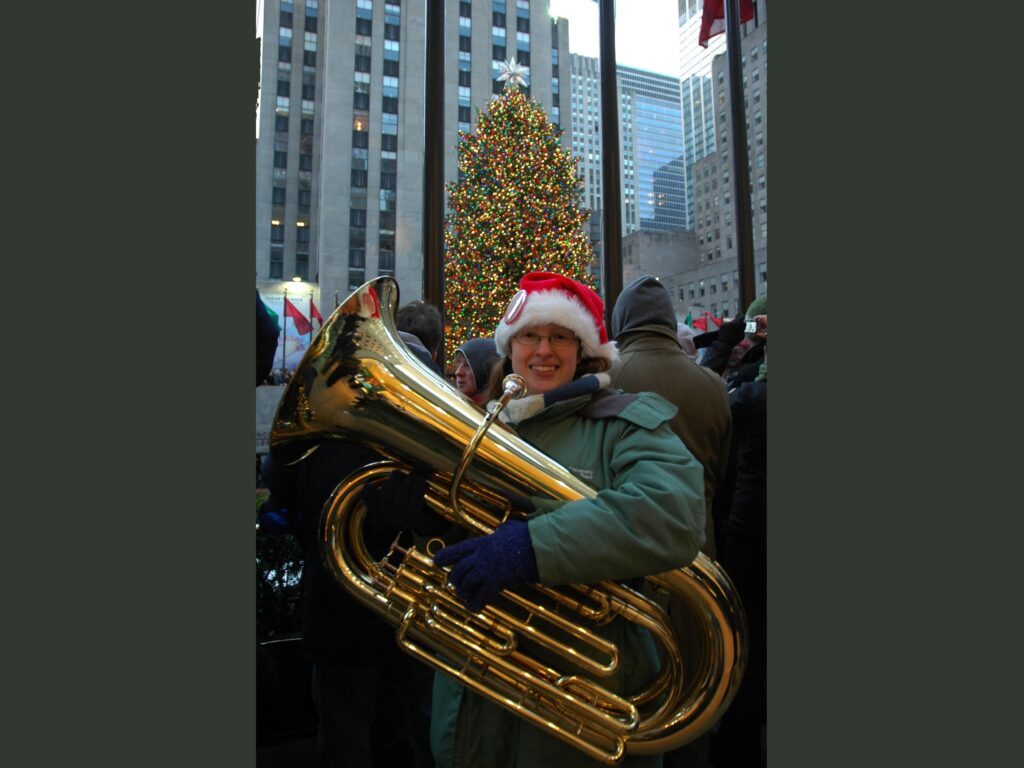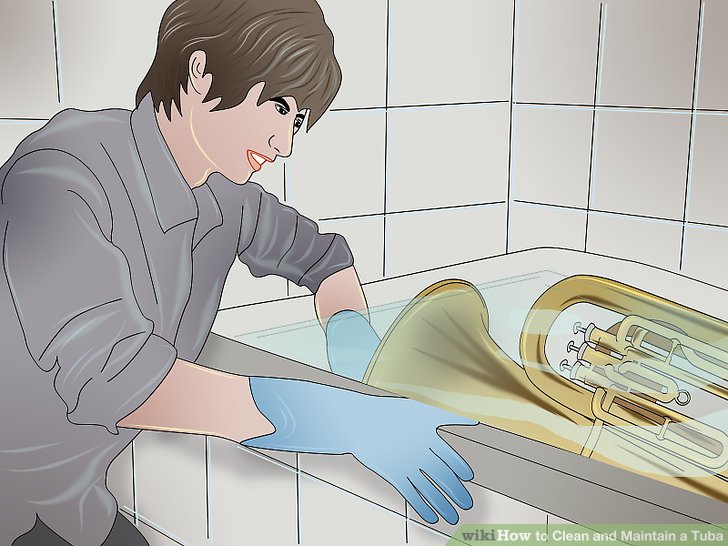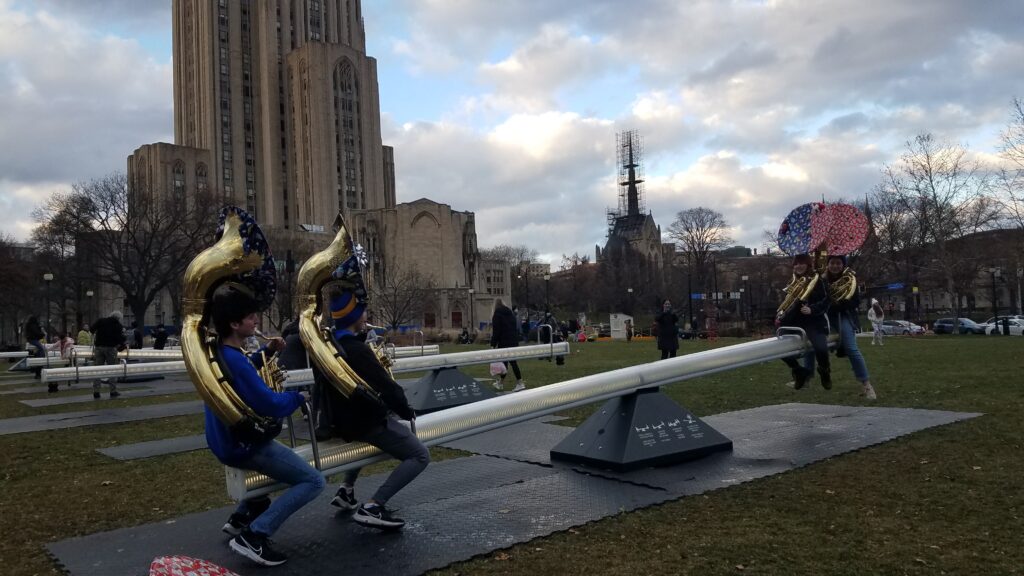Part 2 – Healing
I don’t remember a pre-music time in my life. Even before I started studying an instrument and learning how to read music in elementary school, my mom and I would sing and play records together. As mentioned in last week’s post,[1] I sang through the end of high school, and I played tuba through the end of college. When I moved to Japan, I started to learn shamisen (a serious endeavor) [2] and spent a lot of notably un-serious time releasing pressure at karaoke. After I moved back to the US, I had finally given myself enough space from singing in a formal environment that I was willing to join a local church choir, and I was ultimately in one choir or another for about 10 years, up to the start of the pandemic. My tuba got occasional use during that time (also usually at church), but once I moved into Christian’s house, it languished in the basement with the rest of the things that came from my apartment.
When the pandemic started, my outlets for music went away almost altogether. I was very preoccupied with my new job and with COVID stress, and I wasn’t about to go do any heavy breathing in a closed space with other people. But I didn’t do much music on my own, either, aside from singing along with Handel’s Messiah while baking Christmas cookies. (And even on the rare occasions when I sing in the kitchen, I tend to be incredibly self-conscious, whether or not Christian is home, and try to keep my voice down.) All in all, the last three years spent in various stages of quarantine have been much more about surviving than thriving, at least from a mental health standpoint, and I’ve struggled with how to break out of that pattern.
Restoration
It was after catching up with band friends and reliving rose-colored memories at my high school reunion this fall that I knew I needed to bring music back into my life somehow, no matter how small the opportunity. And I also knew that there was an easy enough way to do it at least once in the short term… one that simply involved showing up at the right place on the right day to make music with other “bandos”: Tuba Christmas. Taking place in cities across the country during the weeks leading up to Christmas, tubas (or sousaphones) and euphoniums (or baritones) have assembled to play Christmas carols from a common songbook for almost half a century.[3]

Photo credit: Arthur Parisi
My first-ever Tuba Christmas was in New York City in 2008. Playing with about 200 other musicians in front of the Christmas tree at Rockefeller Center was an amazing experience and set the bar high for the event, to say the least. But even the smaller annual event in Pittsburgh has been special in its own way on years I’ve been able to go. Unsurprisingly, as schedules get busy, certain activities – no matter how much fun they are – tend to drop off the list. Despite my fond memories of these silly (but still quality) concerts, I had not even touched my poor tuba since 2016 when I did some impromptu busking outside a Pirates game. He (yes, he’s a he) was relegated to the basement ever since and definitely needed some tender loving care before another performance.
Proper care of a wind instrument is more important than you might think. Absolutely, regular maintenance is necessary in order to protect the instrument itself and keep it in good working order, but wind instruments get filled with warm, moist air when played (and also bacteria and food particles if you don’t brush your teeth before playing), meaning that musician health can also be at stake. Although it is a rare occurrence, it is possible to get sick with a type of lung inflammation that can happen if your instrument is harboring certain types of mold.[4] I remember when a music teacher from my elementary school got seriously sick, I heard there was a possibility that it could be related to mold inside his tuba, and that story was at the front of my mind as I pulled my tuba out of the basement after six years. Sadly, it looked like a mouse might have been living in the case at one point, so mold or no, proper sanitation was going to be critical.
There are some great tutorials online about the specific steps necessary to clean a brass instrument, which some people recommend doing as often as once a month.[5] For reference, my dad and I gave my tuba its last thorough washing Christmas 1999, when I first got it. In order to be thorough (and I would have to be), you need to take the instrument entirely apart, remove felt or cork components in the valves, and submerge everything metal in warm, soapy water. (There are instrument-specific cleaners, but dish soap works fine too.) After drying everything off, applying slide grease and valve oil in all the right spots, and polishing to your heart’s content, you should be good to go.[6] However, since I had an increased concern about removing any risk of pathogens, I soaked everything in a sanitizer I use for brewing. (Other hobbies to the rescue!)

Image credit: [7]
Put Your Lips Together and Blow
Cleaning out a tuba is not a quick process, and neither is getting your lips back in shape after years of not blowing into a mouthpiece. My limited range, agility, and endurance were frustrating at first, but it didn’t take long before each of those improved; it took even less time before I was having fun with the music and laughing at things like an ironically low note in “Angels We Have Heard on High.” Taking little bits of time to practice in the weeks leading up to Tuba Christmas didn’t only revive some of my skill but also some of my love for the instrument and for making music in general. (The poetic parallel of me taking care of my tuba and my tuba taking care of me did not go unnoticed.)
I have skipped Tuba Christmas many years because I was too busy with Christmas preparations (cards, cookies, and decorations), but I skipped the last two years mostly because of the pandemic. Although the performances were outside, the rehearsals were inside, and I wasn’t comfortable with that level of exposure, being unmasked around strangers whose vaccine or testing status was not requested in order to participate. I still wasn’t thrilled with the similar setup this year, but I was clearly desperate enough to get music back into my life that I was willing to step outside of my COVID comfort zone. And I have to say that, as the first time performing with others in almost three years, it was amazing. Between the act of creating music together, the Christmas spirit summoned by the songs we played, and the general silliness (planned and unplanned) within the group, I left the concert feeling positively buoyant.
And it’s interesting (to me) that I listed those three aspects of what made the event so enjoyable before I even started reading Catherine Price’s The Power of Fun this week.[8] In her book, she describes “fun” events as having a combination of playfulness, connection, and flow (the state of losing your sense of time and self-awareness). I can say for certain that I experienced all three of those during Tuba Christmas. Incidentally, she also describes how judgment (which has plagued my relationship with vocal music for more than two decades) drops you out of flow and limits your ability to experience fun. (I can’t say that’s news to me, but now there’s qualitative data to back it up.)

So the question I’ve been asking myself is “what’s next?” Clearly I’m capable of enjoying my relationship with music in some instances, but I’m still very much in the “it’s complicated” stage. I want to figure out how can I simply let music be fun: play time, not work time, not an obligation, and not an opportunity for self-judgment. Tuba Christmas felt healthy to me, and I think that warrants some closer examination to identify aspects of what I want my relationship with music to look like (and what I don’t). I initially thought doing that would be about as quick and easy as deep cleaning a tuba… that I could do some introspection in a two-part blog post and resolve an issue that I’ve carried with me for more than half of my life. For the record, my therapist thinks it will probably take a bit longer… in which case, I’ll leave it for now and say that there will be more to come… eventually.
~
If you’ve wrestled with a complicated relationship like the one I have with music, or if you have trouble just allowing yourself to have fun, I’d love to hear how you’re working through it.
Thank you for reading.
[1] https://radicalmoderate.online/angel-of-music-part-1/
[2] https://en.wikipedia.org/wiki/Shamisen
[3] http://www.tubachristmas.com/
[4] https://abcnews.go.com/Health/study-brass-wind-instruments-allergic-lung-disease/story?id=11569520
[5] https://www.wikihow.com/Clean-a-Brass-Instrument
[6] https://www.youtube.com/watch?v=a2Ki5dZ6oPw
[7] https://www.wikihow-fun.com/Clean-and-Maintain-a-Tuba#/Image:Clean-and-Maintain-a-Tuba-Step-3.jpg
[8] https://www.goodreads.com/en/book/show/57569793-the-power-of-fun
1 Comment
Jean · December 18, 2022 at 11:17 am
Sing like nobody is listening and I’m absolutely positive you are selling yourself short❤️